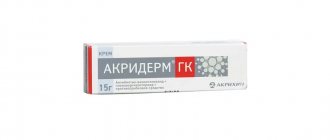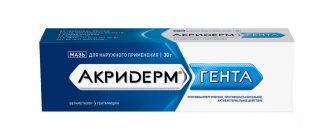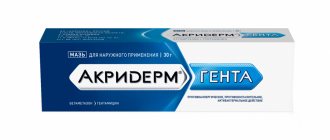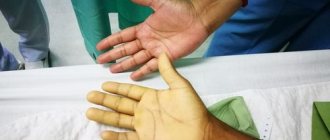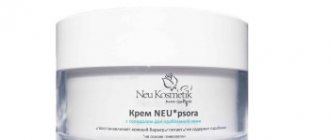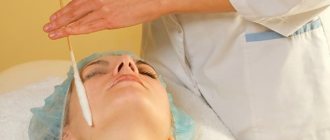The use of external agents is an important component in the treatment of dermatoses. The manifestation of skin pathologies in the form of itching, redness, swelling and pain brings patients not only physiological, but also aesthetic discomfort. Therefore, it is important to choose the right remedy that will help improve the patient’s condition and gradually cure the disease. One of the most preferred medications for solving dermatological problems is Akriderm cream. Thanks to its unique composition, it is able to have a strong effect on the inflammatory focus, thereby reducing the severity of objective and subjective symptoms. From the instructions you will learn about the features of its use, but only a specialist can give more detailed recommendations on how to use the product.
Akriderm - what is this ointment for?
The medication is often used to treat dermatological diseases. It is allowed to be prescribed for:
- simple and allergic dermatitis (especially often in demand after the addition of secondary bacterial or fungal flora);
- widespread and local neurodermatitis (this also includes atopic dermatitis, simple chronic lichen);
- eczematous rashes;
- fungal infections of the skin and nail plates (dermatophytosis, candidiasis, pityriasis rosea).
It is not advisable to use it for a long time without consulting a doctor.
The Akriderm group of medications are recommended for the treatment of dermatomycosis and any skin diseases, including those complicated by secondary bacterial or fungal flora. The medications are well tolerated and effective. They help with both acute and chronic pathologies of the skin. This is confirmed by the scientific work of E.V. Matushevskaya, I.G. Shakurova, Z. R. Khismatulina “Efficacy and tolerability of drugs from the Akriderm line in the practice of a dermatovenerologist.”
How to use Akriderm GK
The Akriderm GK instructions only provide for external use of ointment or cream.
The medicine is used twice a day, gently rubbed into affected areas of the skin. As prescribed by the doctor and depending on the severity of the pathology, an increase or decrease in the number of applications is allowed.
The course of treatment can reach 2-4 weeks, but positive changes are observed already in the first days of application.
It is not recommended to use the product with sealed bandages without a doctor’s recommendation in order to avoid accelerated absorption of the antibiotic and glucocorticosteroid, which increases the likelihood of side effects.
If no improvement is observed with regular use, it is necessary to clarify the diagnosis and reconsider the treatment regimen.
Forms, composition
The medication is available in 2 forms: ointment and cream. The creamy texture is lighter and is distributed evenly over the skin. The ointment has a thicker texture, allowing the active substance to remain on the skin longer.
Forms that differ in composition (line of external products):
- Akriderm ointment and cream 0.05% 15 g, 30 g - contains betamethasone;
- Akriderm SK ointment 30 g, 15 g - contains betamethasone and salicylic acid;
- Akriderm GK ointment and cream is a combined hormonal ointment containing betamethasone, gentamicin, clotrimazole;
- Akriderm Genta ointment and cream 15 g, 30 g - contain betamethasone, gentamicin.
Depending on the pathology, one form or another is chosen.
Betamethasone is a glucocorticosteroid. It relieves inflammation, relieves allergic reactions by reducing swelling and itching.
Gentamicin is an antibacterial component. Kills bacteria. Not active against fungal and viral agents.
Clotrimazole is an antifungal component. It is active against candida fungus, dermatophytes, yeast and other microorganisms.
Salicylic acid has an irritating effect and relieves inflammation. It also promotes the exfoliation of the stratum corneum of the epithelium.
Composition of the drug
Akriderm cream (30 g) is a product for external use that is white or almost white in color. The active substance of the drug is betamethasone dipropionate. Its amount, calculated as 100% of the substance, is 0.064 g, which is equivalent to 0.05 g of betamethasone per 100 g. This ratio classifies Akriderm as a potent drug.
Betamethasone has a variety of effects:
- anti-inflammatory;
- antiallergic;
- antipruritic;
- antiexudative.
Akriderm cream also contains excipients, including purified water, solid and liquid paraffin, petroleum jelly, emulsion wax, sodium sulfite, disodium edetate, propylene glycol and methyl parahydroxybenzoate. These components promote good absorption and penetration into the site of inflammation.
Contraindications
Each form of medication has its own contraindications.
Restrictions on use for all types of medication:
- intolerance to the main and auxiliary components;
- syphilitic damage to the dermis;
- viral skin damage (herpes, chickenpox);
- vaccination and its skin manifestations;
- gaping wounds;
- children under 2 years of age;
- tuberculous damage to the dermis.
The list is supplemented
| Akriderm genta | Akriderm |
|
|
How the drug works
The pharmacological effect of the drug is complex and is determined by the properties of its constituent substances:
- gentamicin has an antibacterial effect, is active against gram-negative bacteria - Proteus, Klebsiella, Enterococcus, Salmonella, Shigella, Staphylococcus;
- clotrimazole has an antifungal effect, destroys the cell membrane of fungi and causes their death. Effective against dermatophytes, mold and yeast-like fungi;
- betamethasone is a hormonal component that fights inflammation, swelling, and has an antiallergic effect.
Undesirable manifestations
When using an external remedy, undesirable manifestations are possible, but they are mild.
Undesirable manifestations in all forms:
- local reactions: itching, burning, dry skin, folliculitis, hypertrichosis, steroid acne, allergic skin manifestations;
- when applying bandages: stretch marks, prickly heat, attachment of secondary flora, weeping;
- systemic manifestations: increased blood pressure, leaching of calcium from bones, weight gain, edema, ulcerative defects of the digestive tract mucosa, exacerbation of focal infections, menstrual irregularities, poor sleep, agitation.
The list is supplemented by the following undesirable manifestations of individual forms:
| Akriderm | Akriderm genta |
|
|
Side effects
When using the drug, side effects are possible, which, as a rule, are mild. Also, the severity of side effects depends on the duration of treatment and the extent of the surfaces on which the cream is applied.
When using Akriderm externally, the following may be observed:
- skin itching;
- burning;
- irritation;
- dry skin;
- folliculitis;
- hypertrichosis;
- striae;
- acne;
- hypopigmentation;
- perioral dermatitis;
- allergic contact dermatitis.
When using Akriderm together with occlusive dressings, skin maceration, secondary infection, skin atrophy, local hirsutism, telangiectasia, miliaria, and purpura are possible. If these adverse reactions occur, as well as those that are not included in the instructions, you must stop therapy and consult a doctor for additional advice.
special instructions
All forms have the same precautions and instructions. Features of use:
- prevent contact of the medication with the mucous membrane of the eyes;
- if secondary flora is attached, you should stop using the external agent;
- The body surface area of a child is smaller than that of an adult patient, so the dose and duration of course therapy should be observed to avoid systemic manifestations.
Features of other forms
| Akriderm | Akriderm genta |
|
|
Akriderm SK
Cream and ointment Akriderm Genta
This is a complex drug that contains: betamethasone + gentamicin.
Betamethasone is described above (read).
Gentamicin is a broad-spectrum antibiotic. It kills microbes that cause various purulent complications on the skin.
In the photo: Akriderm Genta cream
Indications for use
The same as for Akriderm cream (see above) + secondary infection, which can manifest itself as inflammation, redness, and swelling of the skin. There may be a fibrin deposit (purulent coating) on the skin, especially if diaper rash is present. That is, all dermatoses on the skin complicated by infection are indications for the use of Akriderm Genta.
Instructions for use
The manufacturer writes in the instructions that the drug is applied to the skin 2 times a day for a course of up to 4 weeks.
However, according to doctors, taking the drug with an antibiotic for such a long time is not recommended. Typically, dermatologists prescribe Akriderm Genta for a course of 2 weeks - a maximum of 3 weeks if the infection lasts for a long time, and then switch to hormonal ointments without antibiotics.
Contraindications and side effects
The same as Akriderm without antibiotics. Plus, when using Akriderm Genta, skin redness, local skin dysbiosis and the risk of developing a fungal infection are possible due to prolonged treatment with antibiotic ointment.
Analogs
Each form has its own analogue. List of structural substitutes by form (similar in composition):
| Form | Structural substitute |
| Akriderm SK | Rederm |
| Akriderm | Betamethasone-Vertex |
| Akriderm genta | Celestoderm |
| Akriderm GK | Triderm |
Non-structural substitutes contain another active ingredient. These include:
- Hydrocortisone ointment 1% - contains hydrocortisone, less effective, helps with allergic skin diseases without complications.
- Triacort - contains triamcinolone acetonide, helps with eczematous and psoriatic rashes, atopy and other skin pathologies (available strictly according to prescription!).
The choice of a substitute should be made by a doctor.
Akriderm is a popular line of external products in the field of dermatology. It is used for the treatment of skin diseases of various nature, such as complicated dermatitis (caused by allergies), eczema, neurodermatitis, and fungal damage to the skin. For each pathology, a different form of medication is selected that most effectively eliminates the symptoms of the disease. With proper use of drugs, the risk of unwanted effects is minimal.
Akriderm SK cream and ointment
This is a complex ointment containing: betamethasone + salicylic acid.
Betamethasone is described above (read).
Salicylic acid is a product that exfoliates and softens superficial scales on the surface of the skin. A very useful effect for long-term chronic diseases with thickening and excessive peeling of the skin such as psoriasis.
In the photo: Akriderm SK ointment
Indications for use
Akriderm SK ointment is indicated for patients with chronic skin diseases, accompanied by itching, thickening and excessive exfoliation of horny scales from the surface of the skin:
- psoriasis,
- eczema,
- neurodermatitis,
- seborrheic dermatitis of the skin of the face, body,
- lichen planus,
- ichthyosis.
Instructions for use, side effects and contraindications
The same as for simple Akriderm ointment (see above).
This form is present only in the form of an ointment, since it is used only for chronic processes in the skin, accompanied by thickening of the skin.
Attention: do not use Akriderm SK for weeping eczema!
Is Akriderm GK suitable for pregnant women and children?
No studies have been conducted to prove the absolute safety of the drug for pregnant and lactating women. Use ointment or cream with caution; apply only to small areas of the skin for a short period of time. Use is not recommended in the first trimester. If there is an urgent need to use ointment or cream during lactation, breastfeeding should be stopped for the period of treatment.
For children under two years of age, the drug in the form of an ointment is contraindicated according to the instructions. With long-term treatment, use on large skin surfaces and application of dressings, the glucocorticosteroid can penetrate into the systemic circulation.
In children from two to eighteen years of age, use with caution.
On the recommendation of a pediatrician or dermatologist, the cream can be used in the treatment of skin diseases in children over 1 year of age. But only for a short course and on small areas of the skin, since the epidermis in babies is not sufficiently developed and the risk of side effects increases.
Directions for use and dosage
The instructions provide information on the standard use of Akriderm SK. The drug is applied externally to the affected area of the skin using gentle circular movements and light rubbing. The recommended frequency of application is at least 2 times a day - in the morning and evening. In mild cases, a single use is allowed. In case of severe manifestations of the disease or localization of the lesion in areas from which the product can be easily washed off, more frequent application may be necessary.
Another treatment regimen can be established by the doctor, based on the severity of the disease. If improvement does not occur, it is necessary to clarify the diagnosis or adjust therapy.
pharmachologic effect
"Akriderm SK" is a combined preparation for external use that has several effects:
- anti-inflammatory;
- antiallergic;
- antiseptic;
- keratolytic.
Betamethasone dipropionate is a glucocorticosteroid that has antiexudative, decongestant and antipruritic effects. It mainly affects leukocytes, slowing down their accumulation. It also inhibits the release of lysosomal enzymes and pro-inflammatory mediators at the site of inflammation, inhibits phagocytosis, reduces vascular tissue permeability, and prevents the formation of inflammatory edema.
Keratolytic and antimicrobial effects are provided by salicylic acid, which also eliminates horny deposits.
